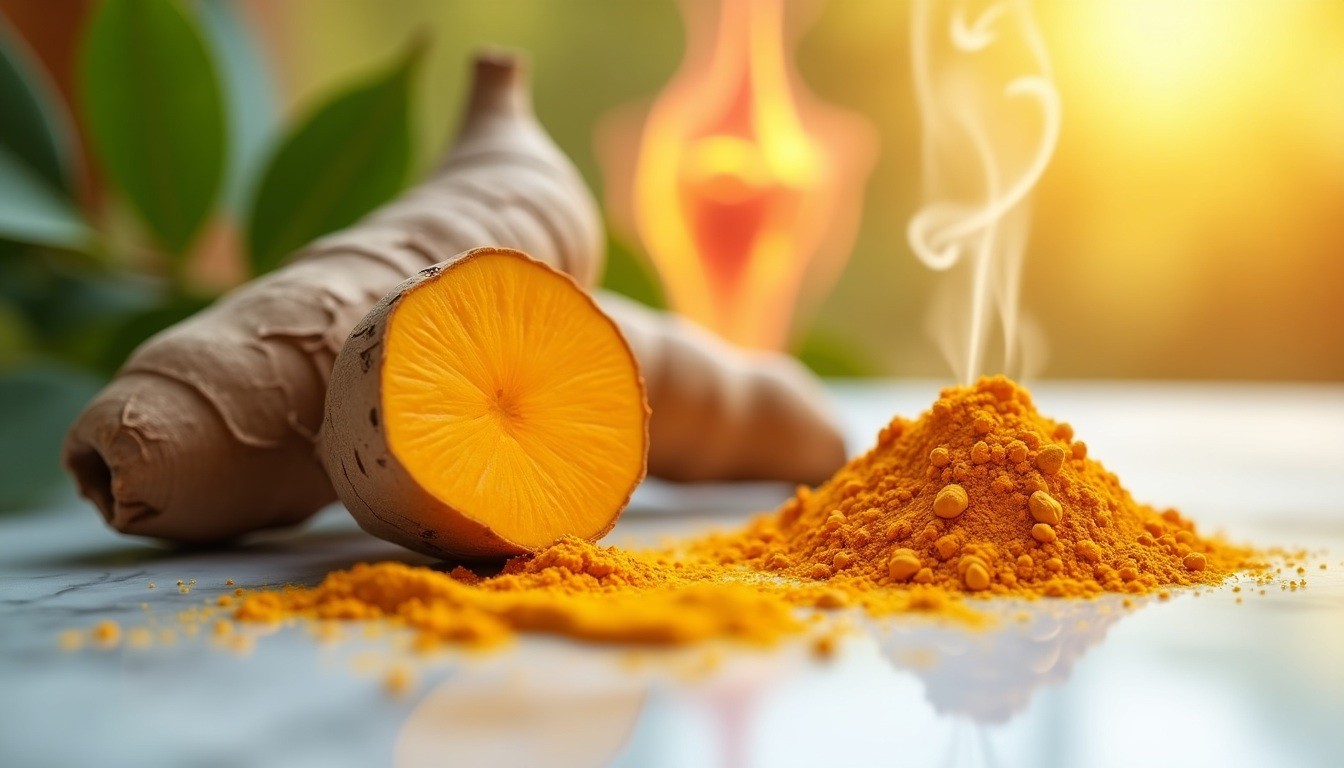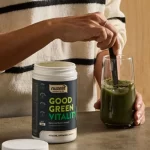

Clinical trials show that turmeric for joint pain works as well as common anti-inflammatory medications. A newer study with 107 people who had kneeosteoarthritis showed turmeric gave better pain relief than ibuprofen, especially when they climbed stairs.
The science behind this ancient spice tells a fascinating story. Turmeric’s active compound curcumin has strong anti-inflammatory properties that help treat arthritis and chronic pain. Research proves that people can safely take 1 to 10 grammes of turmeric daily and get amazing benefits for their joints.
This piece looks at the science that proves turmeric works, explains why doctors now recommend it more often, and gives you detailed information about the best ways to use it.
Scientists worldwide are fascinated by how turmeric works at the molecular level to relieve joint pain. Curcumin is the powerhouse behind this golden spice and makes up 3-5% of turmeric powder [1].
Curcumin uses multiple pathways to curb joint inflammation. It blocks several pro-inflammatory signals, such as prostaglandins, leukotrienes, and cyclooxygenase- 2 [2]. The compound also reduces vital inflammatory mediators, including tumour necrosis factor-α (TNF-α), various interleukins, and nitric oxide synthase [2].
Besides curcumin, turmeric has several beneficial compounds:
These compounds influence multiple cellular pathways:
Studies consistently show how well turmeric works for joint pain management. A groundbreaking study found that 94% of people taking curcumin saw their arthritis symptoms improve by at least 50% [3]. Research also shows that turmeric extract can match paracetamol’s pain-relieving effects with minimal side effects [2].
A meta-analysis revealed that curcuminoids worked better than standard treatments for pain relief. Scientists measured this using both visual analogue scale (VAS) and Western Ontario and McMaster Universities Arthritis Index (WOMAC) pain scores [2]. Many researchers now suggest using curcuminoids alongside regular treatments for knee osteoarthritis [2].
Turmeric helps with joint conditions of all types. Taking 1 gramme of curcumin daily for 8-12 weeks reduces osteoarthritis symptoms effectively [4]. Studies also show that turmeric’s anti-inflammatory properties work directly on chondrocytes by blocking specific enzymes that speed up cartilage breakdown [5].
Medical professionals worldwide now recognise turmeric’s potential to manage joint pain, with strong clinical evidence supporting this claim. A systematic review of randomised clinical trials showed that standardised turmeric extracts (1000 mg/day of curcumin) reduce arthritis symptoms effectively [4].
Clinical studies prove how well turmeric works for joint pain management. The results are impressive – 94% of patients who took curcumin saw their arthritis symptoms improve by at least 50%. These results match diclofenac’s 97% success rate [6].
Notable research findings include:
Medical experts now see turmeric as a good option for patients who can’t handle traditional medications. The Arthritis Foundation suggests taking 500 mg capsules of curcumin extract twice daily. This recommendation applies to both osteoarthritis and rheumatoid arthritis patients [6].
A newer study of 139 patients with knee osteoarthritis showed that curcumin works just as well as diclofenac for pain relief [7]. Turmeric’s advantages over conventional treatments include:
Research shows that no patients taking curcumin needed treatment for stomach issues. However, 28% of those on diclofenac required such help [6]. These findings suggest turmeric works best for patients who experience side effects from traditional NSAIDs [4].
The medical community accepts turmeric more widely now because it matches conventional treatments’ effectiveness and offers a better safety profile. A complete analysis of multiple studies shows that turmeric therapy could work as well as NSAID treatment for pain relief and function [4].
Research shows that turmeric works differently for joint conditions of all types. This natural remedy helps with various forms of joint pain. Clinical studies that are many years old highlight its wide-ranging benefits through multiple ways it works in the body.
Turmeric has delivered remarkable results for both osteoarthritis and rheumatoid arthritis patients. A complete study with 107 participants who had knee osteoarthritis showed better pain relief in people taking turmeric, especially when they climbed stairs [9].
Arthritis patients experienced these benefits:
Studies confirm that 8-12 weeks of standardised turmeric extract (1000 mg/day of curcumin) can reduce arthritis symptoms effectively [10].
Athletes and sports medicine experts now recognise turmeric’s role in injury recovery. A groundbreaking study with elite male footballers showed that turmeric supplementation reduced muscle soreness and inflammation markers after matches by a lot [11].
The research revealed lower plasma CRP levels (a key inflammation marker) 64 hours after matches [11]. Players reported less muscle soreness at all post-match checkpoints because of turmeric’s anti-inflammatory and pain-relieving properties [12].
Age-related joint problems affect much of the older population. Studies show that more than 10% of men and 13% of women over 60 have knee arthritis symptoms[13].
A clinical trial with people over 40 who had knee osteoarthritis revealed these results:
Turmeric does more than just relieve pain. Research suggests it can protect joint cartilage and slow down age-related joint deterioration [4]. The spice fights inflammation by blocking specific enzymes that speed up cartilage breakdown, which makes it valuable to manage long-term joint health [4].
You need to understand the best ways to take this powerful supplement to get maximum benefits from turmeric for joint pain. The supplement’s effectiveness depends on its form, dosage, and how your body absorbs it.
Several forms of turmeric supplements are available in the market, each offering unique benefits:
Research shows specific dosage ranges work best for joint pain relief. Experts recommend these amounts for osteoarthritis and rheumatoid arthritis:
| Condition | Daily Dosage | Frequency |
| Osteoarthritis | 400-600mg | Three times daily [3] |
| Rheumatoid Arthritis | 500mg | Twice daily [3] |
Research indicates doses between 500–2,000mg of turmeric daily can work [5]. Keep in mind that turmeric spices contain about 3% curcumin, while extracts can contain up to 95% [5].
Curcumin’s effectiveness faces a challenge – only 2-3% reaches the bloodstream [16]. Here are some proven ways to boost its bioavailability:
Black Pepper Integration Black pepper extract (piperine) boosts curcumin absorption by up to 2,000% [5]. This explains why many prominent supplements include BioPerine, a patented form of piperine [17].
Fat-Based Solutions Curcumin dissolves in fat, so taking it with healthy fats improves absorption. Taking turmeric with these foods helps:
Advanced Formulations Modern supplement technology has created several absorption-boosting methods:
Taking turmeric supplements with fatty meals gives the best results [3]. The World Health Organisation states 1.4 mg per pound of body weight is a safe daily intake [5].
New research confirms turmeric works well for joint pain management. Recent clinical trials have shown exciting results about this ancient remedy’s modern uses.
A key study with 139 knee osteoarthritis patients showed turmeric extract is a match for common painkillers. The results were impressive – 94% of people taking curcumin saw their symptoms improve by at least 50%, close to 97% in the diclofenac group [7].
The study showed these great benefits of turmeric:
Clinical evidence backs turmeric’s effectiveness in joint conditions of all types. A complete analysis of eleven studies, with 1,258 knee osteoarthritis participants, showed curcuminoids gave better pain relief than standard treatments [2].
| Treatment Comparison | Key Findings |
| Curcumin vs. Paracetamol | Equally effective in reducing pain [8] |
| Curcumin vs. NSAIDs | Better tolerance and fewer side effects [2] |
| High vs. Low Dose | Similar effectiveness across dosage ranges [2] |
Eight randomised clinical trials showed taking 1,000 mg of curcumin daily for 8-12 weeks helps reduce arthritis symptoms [10]. These improvements matched the benefits you’d get from ibuprofen and diclofenac sodium [10].
Scientists are working to tap into turmeric’s full therapeutic potential. Their current focus includes:
UCLA researchers are studying how curcumin affects rheumatoid arthritis in a randomised, placebo-controlled crossover study with 40 people [1]. Each participant gets 4g of curcumin daily while researchers track blood markers and clinical outcomes.
Scientists have found new ways to boost curcumin’s bioavailability. A breakthrough study showed absorption improved by a lot when combined with phosphatidyl choline [1]. Several companies are now developing better formulations that your body can absorb more easily.
Research continues on how turmeric might help different joint conditions. A review of clinical trials showed bioavailable turmeric extract reduces inflammatory markers CRP and TNF-α [8]. These findings suggest turmeric could be a safer option than traditional anti-inflammatory medications, especially when used long- term.
You can maximise turmeric’s benefits for joint pain relief by knowing how to combine it safely with other treatments. The right knowledge about interactions and timing leads to optimal results.
Turmeric’s combination with conventional treatments needs careful thought. Research shows turmeric might interact with several medications:
| Medication Type | Interaction Effect | Precaution |
| Blood Thinners | Increases bleeding risk [19] | Avoid combination |
| Diabetes Medications | May lower blood sugar further [19] | Monitor levels |
| Antacids | Affects stomach acid production [19] | Space timing |
| Blood Pressure Medicines | May boost effects [20] | Regular monitoring |
Patients on chemotherapy should ask their healthcare provider before taking turmeric supplements [19]. Turmeric might change how certain cancer medications work [20].
Scientists have found several beneficial combinations that boost turmeric’s effectiveness:
Studies suggest that combining turmeric with other natural anti-inflammatory compounds works better than using it alone. These combinations target different aspects of joint inflammation through multiple pathways [22].
The right timing of turmeric supplements helps maximise benefits and minimise potential interactions. Here are the significant guidelines:
1) Medication Spacing:
2) Optimal Absorption:
You should stop taking turmeric supplements at least two weeks before scheduled surgery [19]. Open communication with healthcare providers about supplement use helps ensure safety.
A well-laid-out approach works best when using multiple treatments:
Some people should be extra careful:
Studies show turmeric can safely complement conventional pharmaceutical therapies for knee osteoarthritis. This might help reduce doses of medications like NSAIDs [4]. Patients who used turmeric combinations needed less rescue medication for pain relief [4].
Safety plays a crucial role to use turmeric supplements effectively for joint pain relief. You should understand the risks and interactions to get optimal benefits and minimise side effects.
Turmeric can interact with several types of medications, so you need to be careful:
| Medication Type | Risk Level | Potential Effects |
| Blood Thinners | High | Increased bleeding risk [23] |
| Diabetes Medications | Moderate | Enhanced blood sugar reduction [19] |
| Antacids | Moderate | Increased stomach acid production [19] |
| Chemotherapy Drugs Remove | High | Altered medication effectiveness [24] |
Patients who take blood-thinning medications like warfarin need extra caution. Turmeric might boost their effects and increase bleeding risks [23]. People using diabetes medications should watch their blood sugar levels closely since turmeric may cause additional reduction [19].
These groups should be careful or avoid turmeric supplements:
Patients getting chemotherapy treatments should talk to their healthcare provider, especially if they take specific agents like camptothecin, mechlorethamine, doxorubicin, or cyclophosphamide [24].
Most people handle turmeric well. A study with 24 participants showed that seven people reported adverse reactions, mostly at doses above 4,000 mg [13]. Common side effects include:
1) Digestive Issues:
2) Other Reactions:
Here are some strategies to stay safe:
Research shows that doses of 500 mg or higher might cause headache and nausea in some people [26]. Turmeric supplements are safe for most people when taken correctly, but high doses could increase side effect risks [24].
Taking supplements with food helps reduce digestive discomfort. Clinical trials have shown that turmeric is safe in doses of 1-10g daily for up to 2-3 months [27].
Ground experiences and solid evidence show how turmeric supplements reshape the lives of people with joint pain. Clinical studies and patient stories prove that turmeric works well to manage arthritis and joint conditions of all types.
A breakthrough clinical trial with 139 participants showed remarkable results in pain management. The study revealed that 94% of people taking curcumin saw at least 50% improvement in their arthritis symptoms. This matched traditional NSAIDs which had a 97% success rate [6].
The trial showed these key differences between treatments:
Another study with 36 rheumatoid arthritis patients provided more proof. After 90 days of treatment with bioavailable turmeric formulation, patients saw substantial improvements in:
| Symptom | Improvement Noted |
| Joint Pain | Major reduction |
| Inflammation | Clear decrease |
| Morning Stiffness | Notable improvement |
| Physical Function | Better mobility |
Kim Scott’s story stands out. At 50, she dealt with severe knee pain for over five years. Her original symptoms included:
Kim added 3 grammes of ground turmeric to her daily diet and saw big improvements within weeks [28]. Her recovery showed:
A detailed study looked at 70 people over 40 with knee osteoarthritis. The group took 1000 mg daily turmeric extract for 12 weeks and reported much less knee pain than those on placebo [13].
Studies over time verify turmeric’s lasting benefits for joint health. A systematic review of randomised controlled trials confirmed that turmeric therapy worked as well as NSAID therapy for pain and function [4].
Clinical settings showed these long-term benefits:
1) Lasting Pain Management:
2) Safety Profile:
A 2021 review of 15 randomised controlled trials showed that curcumin helped with osteoarthritis pain and stiffness as well as or better than NSAIDs [16]. Both 250mg and 500mg twice-daily doses worked better than placebo treatments in every measure [16].
A 2019 month-long study compared 500mg of turmeric (three times daily) with 50mg of diclofenac (twice daily). Both treatments relieved symptoms equally, but turmeric users had fewer side effects [29].
Patient experiences show that turmeric does more than just relieve pain. Many people report a better quality of life, improved physical function, and less dependence on regular pain medications [4]. This clinical evidence proves turmeric’s value as a green solution to manage joint health over time.
Scientific evidence shows that turmeric works as a natural remedy to manage joint pain. Clinical trials show turmeric matches or outperforms conventional medications and has a better safety profile. Standardised turmeric extracts provide lasting relief through multiple anti-inflammatory pathways without causing unwanted side effects.
The right dosage and proper absorption are vital factors. Research confirms that 500-2000mg daily gives optimal benefits to most people. Medical professionals now see turmeric as a viable alternative or addition to traditional joint pain treatments. This is especially true when patients want natural solutions with fewer complications.
Clinical success rates show 94% improvement in arthritis patients, which demonstrates turmeric’s potential. These impressive results and minimal side effects make turmeric a promising long-term solution for joint conditions of all types. The expanding scientific research keeps building a stronger case for this ancient remedy’s modern uses.
Q1. How effective is turmeric for joint pain relief?
Clinical studies have shown that turmeric can be as effective as common anti-inflammatory medications for joint pain relief. In one study, 94% of participants taking curcumin (the active compound in turmeric) reported at least 50% improvement in arthritis symptoms, comparable to conventional treatments.
Q2. How long does it take to see results from taking turmeric for joint pain?
Research indicates that taking standardised turmeric extracts (1000 mg/day of curcumin) for 8-12 weeks can effectively reduce arthritis symptoms and joint pain. However, individual results may vary, and some people may notice improvements sooner.
Q3. What are the potential benefits of taking turmeric daily?
Regular turmeric consumption may help reduce inflammation, relieve joint pain, improve mobility, and enhance overall joint health. Some studies also suggest it may have positive effects on digestive health and provide antioxidant benefits.
Q4. Are there any side effects or safety concerns with turmeric supplements?
While turmeric is generally well-tolerated, some people may experience mild side effects such as digestive issues or headaches, particularly at higher doses. It’s important to consult with a healthcare provider before starting turmeric supplements, especially if you have pre-existing medical conditions or are taking other medications.
Q5. What’s the recommended dosage of turmeric for joint pain?
Clinical studies have established effective dosage ranges of 500-2000 mg of turmeric extract per day for joint pain relief. For osteoarthritis, experts often recommend 400-600 mg three times daily, while for rheumatoid arthritis, 500 mg twice daily is commonly suggested. It’s best to start with lower doses and gradually increase as needed.






Accepting payments via


YourHealthBasket © 2025
detoxpeople Ltd
Registered in England & Wales 07156741
VAT reg GB 103 3641 60
Our new practitioner portal has been released and it’s now easier than ever to link a client’s account and provide them with suggestions using our new protocol system.
Convert your current cart into a protocol which can then be assigned to a linked client.